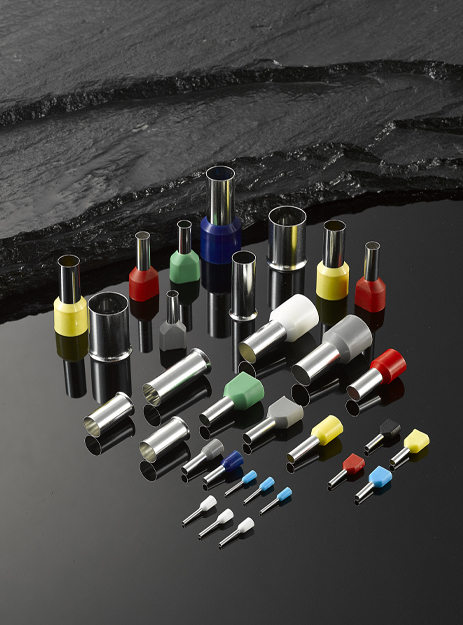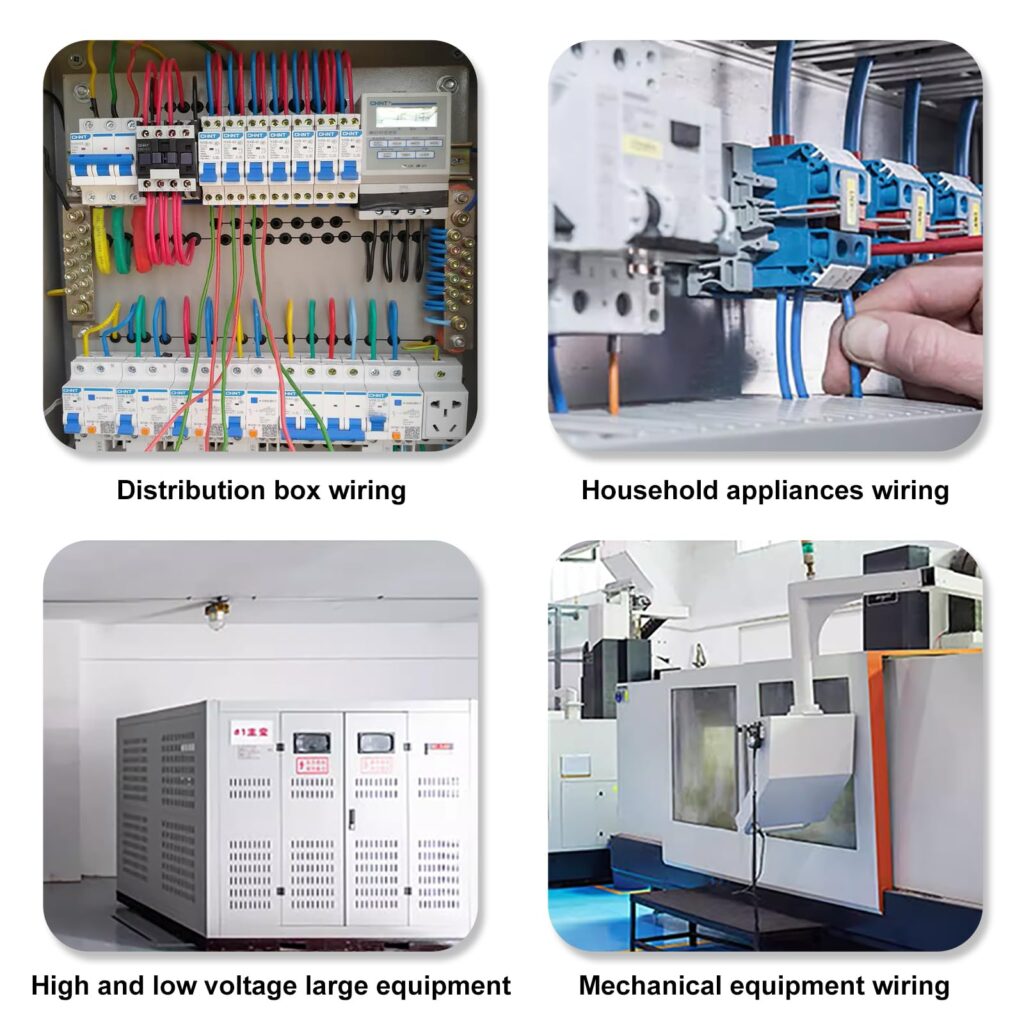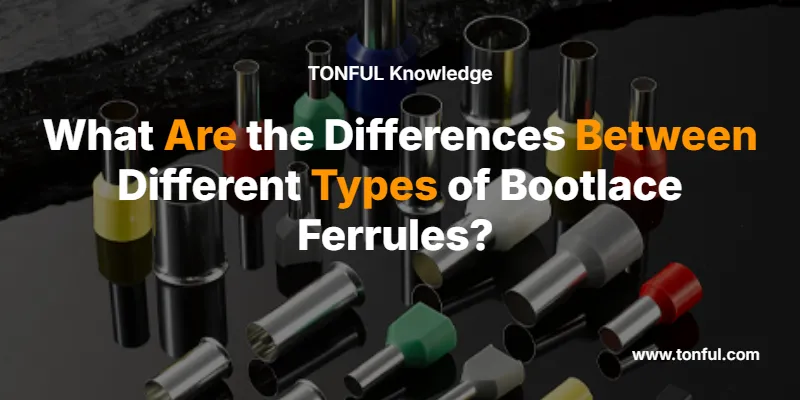Bootlace ferrules are essential electrical components that transform stranded wire ends into solid, reliable connection points. Understanding the different types ensures safe, compliant electrical installations and prevents wire fraying, connection failures, and potential safety hazards.
What Are Bootlace Ferrules? Essential Definitions

Bootlace Ferrule: A small metal tube (usually tin-plated copper) crimped onto stranded wire ends to create a solid termination point that prevents wire fraying and ensures reliable electrical connections.
Alternative Names: Wire end sleeves, cable end sleeves, cord end terminals, wire ferrules, crimp sleeves
Primary Function: Convert flexible stranded wire into a solid conductor suitable for screw terminals, push-in connectors, and terminal blocks
Industry Standards: Comply with IEC 60947-7-4, UL 486E, and CSA C22.2 standards for electrical safety and performance
Key Differences Between Bootlace Ferrule Types
1. Insulation Classification
| Feature | Insulated Ferrules | Non-Insulated Ferrules |
|---|---|---|
| Electrical Protection | Full insulation sleeve prevents short circuits | Exposed metal requires careful spacing |
| Wire Identification | Color-coded for easy circuit identification | No visual identification aid |
| Application Range | General electrical work, control panels | High-current applications, minimal space |
| Safety Level | Enhanced protection against accidental contact | Requires professional installation |
| Cost | Slightly higher due to insulation material | Lower cost, basic functionality |
| Space Requirements | Larger diameter due to insulation | Compact, minimal space consumption |
2. Material Composition Types
Tin-Plated Copper Ferrules
- Superior corrosion resistance
- Excellent conductivity (up to 58 MS/m)
- Prevents oxidation in humid environments
- Complies with RoHS regulations
- Standard choice for most applications
Bare Copper Ferrules
- Maximum electrical conductivity
- Lower cost option
- Suitable for dry, controlled environments
- Requires additional protection in corrosive conditions
- Limited shelf life due to oxidation
Nickel-Plated Options
- Enhanced corrosion resistance
- High-temperature applications (up to 105°C)
- Marine and industrial environments
- Premium pricing for specialized uses
3. Size and Wire Gauge Classifications
| Wire Size (mm²) | AWG Equivalent | Color Code (Standard) | Typical Applications |
|---|---|---|---|
| 0.5mm² | 20 AWG | White | Signal wires, sensors |
| 0.75mm² | 18 AWG | Gray | Control circuits |
| 1.0mm² | 17 AWG | Red | Low-power devices |
| 1.5mm² | 16 AWG | Black | General wiring |
| 2.5mm² | 14 AWG | Blue | Branch circuits |
| 4.0mm² | 12 AWG | Green | Motor connections |
| 6.0mm² | 10 AWG | Yellow | High-current devices |
| 10mm² | 8 AWG | Orange | Industrial equipment |
| 16mm² | 6 AWG | Pink | Heavy machinery |
| 25mm² | 4 AWG | Brown | Main feeders |
| 35mm² | 2 AWG | Light Blue | Service entrances |
Color Coding Systems and Standards
European DIN 46228 Standard Color Codes
Primary Color System:
- White: 0.5mm² – Signal and control wiring
- Gray: 0.75mm² – Low-voltage applications
- Red: 1.0mm² – Standard building wiring
- Black: 1.5mm² – General electrical work
- Blue: 2.5mm² – Branch circuit wiring
- Green: 4.0mm² – Motor and equipment connections
Benefits of Color Coding:
- Instant wire size identification
- Reduces installation errors
- Simplifies maintenance and troubleshooting
- Enhances electrical safety compliance
⚠️ Safety Warning: Always verify wire size with proper gauges – color coding can vary by manufacturer
Applications and Use Cases

Control Panel Wiring
- Best Choice: Insulated ferrules with color coding
- Wire Sizes: 0.5mm² to 2.5mm² most common
- Benefits: Easy identification, enhanced safety
- Standards: Must comply with UL 508A panel building standards
Industrial Machinery
- Best Choice: Non-insulated for high-current, insulated for control
- Wire Sizes: 4.0mm² to 25mm² typical
- Considerations: Temperature rating, vibration resistance
- Standards: NEMA and IEC compliance required
Building Electrical Systems
- Best Choice: Insulated ferrules for safety
- Wire Sizes: 1.5mm² to 6.0mm² standard
- Requirements: Local electrical code compliance
- Installation: Licensed electrician recommended
Marine and Automotive
- Best Choice: Tin-plated with heavy insulation
- Special Requirements: Corrosion resistance critical
- Temperature Range: -40°C to +105°C operation
- Standards: ABYC (marine) or SAE (automotive) compliance
How to Select the Right Bootlace Ferrule Type
Step 1: Determine Wire Specifications
- Measure wire cross-sectional area (mm²)
- Count number of strands in conductor
- Verify insulation material compatibility
- Check operating temperature requirements
Step 2: Assess Application Requirements
- High-current applications: Consider non-insulated
- Dense wiring panels: Choose insulated with color coding
- Outdoor/marine use: Select enhanced corrosion protection
- Safety-critical systems: Prioritize insulated types
Step 3: Verify Compliance Standards
- Check local electrical codes
- Confirm UL/CSA listing requirements
- Verify environmental rating needs
- Ensure proper installation tool availability
Step 4: Calculate Quantity Requirements
- Count total connections needed
- Add 10-15% for installation waste
- Consider future expansion needs
- Plan for maintenance spares
Installation Best Practices and Safety
Required Tools
- Crimping Tool: Proper ferrule crimper (not wire strippers)
- Wire Strippers: Clean, precise cuts essential
- Gauge Checker: Verify wire size accuracy
- Inspection Light: Ensure proper crimp quality
Step-by-Step Installation Process
- Strip Wire Insulation
- Remove insulation length equal to ferrule barrel
- Avoid nicking individual strands
- Keep stripped length minimal for safety
- Insert Wire into Ferrule
- Push wire fully into ferrule barrel
- Ensure no strands extend beyond ferrule
- Verify proper fit – not loose or forced
- Crimp Ferrule Properly
- Use designated crimping tool
- Apply firm, even pressure
- Check for hexagonal crimp profile
- Ensure no loose strands visible
- Quality Inspection
- Verify secure mechanical connection
- Check for proper electrical continuity
- Confirm no exposed strands
- Test pull strength if critical application
⚠️ Critical Safety Notes:
- Never use pliers for crimping ferrules
- Always verify wire size before installation
- Inspect crimp quality on safety-critical connections
- Follow manufacturer’s torque specifications for terminals
Troubleshooting Common Problems
Poor Connection Issues
Symptoms: High resistance, heating, intermittent operation
Causes: Undersized ferrule, poor crimp, oxidized surfaces
Solutions: Verify size compatibility, use proper crimping tool, clean connections
Wire Strand Breakage
Symptoms: Reduced current capacity, connection failure
Causes: Over-crimping, wrong tool, damaged wire
Solutions: Use calibrated crimping tool, inspect wire before installation
Corrosion Problems
Symptoms: Green oxidation, high resistance, connection failure
Causes: Moisture ingress, dissimilar metals, poor environmental protection
Solutions: Use tin-plated ferrules, apply protective coatings, improve sealing
Expert Tips for Professional Results
💡 Professional Tip: Always use a pull test on critical connections – properly crimped ferrules should withstand 50-100N pull force depending on wire size.
💡 Quality Indicator: A properly crimped ferrule creates a hexagonal profile with no visible wire strands and maintains wire flexibility just behind the crimp.
💡 Maintenance Advantage: Color-coded ferrules reduce troubleshooting time by up to 40% in complex control panels.
💡 Cost Optimization: Buying ferrules in bulk kits (mixed sizes) reduces per-unit cost by 25-30% compared to individual purchases.
When to Consult Electrical Professionals
Require Professional Installation:
- Main electrical panel connections
- High-voltage applications (>600V)
- Safety-critical systems (medical, aviation)
- Complex industrial control systems
Professional Certification Requirements:
- Licensed electrician for building wiring
- Certified panel builder for UL 508A compliance
- Factory-trained technician for specialized equipment
Quick Reference Selection Guide
For General Building Wiring
- Type: Insulated ferrules
- Material: Tin-plated copper
- Sizes: 1.5mm² to 6.0mm²
- Standards: UL Listed, CSA approved
For Control Panel Work
- Type: Insulated with color coding
- Material: Tin-plated copper
- Sizes: 0.5mm² to 4.0mm²
- Standards: UL 486E compliance
For Industrial Applications
- Type: Non-insulated for power, insulated for control
- Material: Tin-plated copper or nickel-plated
- Sizes: 4.0mm² to 35mm²
- Standards: IEC 60947 compliance
For Marine/Automotive Use
- Type: Insulated with enhanced corrosion protection
- Material: Tin-plated copper
- Temperature: -40°C to +105°C rating
- Standards: ABYC or SAE compliance
Frequently Asked Questions
What makes insulated ferrules different from non-insulated ones?
Insulated ferrules include a plastic sleeve that provides electrical insulation and color coding for wire identification, while non-insulated ferrules are bare metal tubes offering maximum conductivity and minimal space requirements.
Can you use bootlace ferrules with solid wire?
No, bootlace ferrules are specifically designed for stranded wire. Solid wire already provides the firm connection point that ferrules create for stranded wire.
How do you determine the correct ferrule size?
Measure the wire’s cross-sectional area in mm² or AWG, then select a ferrule with matching specifications. The wire should fit snugly without forcing or excessive looseness.
Are color-coded ferrules required by electrical codes?
While not always mandatory, color-coded ferrules are strongly recommended for complex installations and may be required by specific standards like UL 508A for industrial control panels.
What’s the difference between crimping tools for ferrules?
Ferrule crimping tools create a hexagonal crimp profile that provides optimal connection strength, while standard wire crimpers may damage ferrules or create unreliable connections.
How long do bootlace ferrules last in electrical installations?
Quality tin-plated ferrules can last 20+ years in normal indoor environments. Marine or industrial applications may require replacement every 5-10 years depending on environmental conditions.
Can you reuse bootlace ferrules if you make a wiring mistake?
No, once crimped, ferrules cannot be reused safely. The crimping process permanently deforms the metal, and attempting removal typically damages both the ferrule and wire.
What safety standards apply to bootlace ferrules?
Primary standards include IEC 60947-7-4 (international), UL 486E (North America), and CSA C22.2 (Canada). Always verify local code requirements for specific applications.

